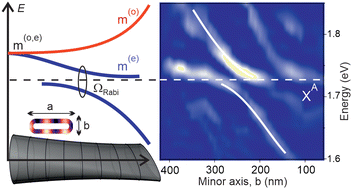A single nanotube synthesized from a transition metal dichalcogenide (TMDC) exhibits strong exciton resonances and, in addition, can support optical whispering gallery modes. This combination is promising for observing exciton-polaritons without an external cavity. However, traditional energy-momentum-resolved detection methods are unsuitable for this tiny object. Instead, we propose to use split optical modes in a twisted nanotube with the flattened cross-section, where a gradually decreasing gap between the opposite walls leads to a change in mode energy, similar to the effect of the barrier width on the eigenenergies in the double-well potential. Using micro-reflectance spectroscopy, we investigated the rich pattern of polariton branches in single MoS2 tubes with both variable and constant gaps. Observed Rabi splitting in the 40–60 meV range is comparable to that for a MoS2 monolayer in a microcavity. Our results, based on the polariton dispersion measurements and polariton dynamics analysis, present a single TMDC nanotube as a perfect polaritonic structure for nanophotonics.

